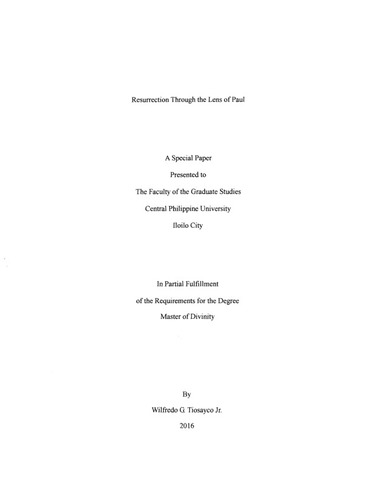Resurrection through the lens of Paul
| dc.contributor.adviser | Pagara, Bernabe C. | |
| dc.contributor.author | Tiosayco, Wilfredo G. Jr. | |
| dc.date.accessioned | 2022-05-30T02:10:20Z | |
| dc.date.available | 2022-05-30T02:10:20Z | |
| dc.date.issued | 2016 | |
| dc.identifier.citation | Tiosayco, W. G. (2016). Resurrection through the lens of Paul Unpublished Master’s special paper). Central Philippine University, Jaro, Iloilo City. | en_US |
| dc.identifier.uri | https://hdl.handle.net/20.500.12852/2070 | |
| dc.description | Introduction | en_US |
| dc.description.abstract | The resurrection, a word which has developed and solely attributed to the resurrection of Jesus of Nazareth also known as Christ, has always been felt to be vital in connection with Christianity. Christian faith emphasizes, as depicted from the very early preaching in Jerusalem recorded in Acts 1:22; 2:24,32; 3:15, that resurrection revolves around the belief that Jesus rose from the dead after He died on the cross. This faith confession is found also in the Nicean Creed and in the Christian doctrines today. It is safe to assume that from the earliest time until now Christian Churches were built on the belief in the Resurrection. One of the vital propagators of resurrection faith is no other than Paul. For Paul, without it [resurrection] Christian preaching and faith were in vain and empty as reflected in his letter to the Corinthian church “And if Christ has not been raised, our preaching is useless and so is your faith” (1 Cor 15:14). Paul realized that understanding what resurrection really is, its spiritual implications as well as its faith value, is a vital importance in the propagation of Christian faith. It should always be taken in consideration that resurrection as the raising of an individual from death is not a unique idea in the Christian faith. In Egyptian, Greek, Roman and Celtic faith traditions resurrection plays a vital role though it has a different spiritual implication and faith value compared in Christianity. In Philippine culture, especially in Iloilo, resurrection stories are also common tales in folklore and epics. For instance, the story of Maranhig that talks about dead people resurrecting from their graves and roaming the villages stealing corpses for their consumption is a widely circulated story in the rural areas of Iloilo. It is even said that the tradition people keeping watch in the wake of their loved ones originated in the fear that the Maranhig would steal the corpse of their loved ones and replace it with a banana trunk. With this knowledge in hand, it is inadequate to preach and teach resurrection to Filipino congregation with the assumption that they would readily understand resurrection as Paul understood it in his encounter with Christ on the road to Damascus. Paul was born in a different region with a different culture, different society and different beliefs. This paper would like to narrow this contextual gap between Paul and the Filipinos by viewing resurrection through the lens of Paul in order to better understand the spiritual implications and the faith value of resurrection. In order to do so the researcher utilized biographical, historical, and exegetical studies in the entire course of the research work. Statement of the Problem What is the Pauline theology of resurrection? How did the Pauline theology develop? What are the lenses that contributed to the biases of Pauline theology of resurrection? Objectives of the Study The General Objective of the the Study is to view Resurrection in the lens of Paul. The Specific objectives are the following: 1. To determine Paul’s concept of Resurrection in his letter to the Corinthians (I Corinthians 15). 2. To determine the educational influences that contribute to Paul’s theology of resurrection. 3. To determine the cultural influences that contribute to Paul’s theology of resurrection. 4. To determine the personal experiences that contribute to Paul’s theology of resurrection. 5. To view resurrection in the line of Paul’s educational, cultural and personal background. | en_US |
| dc.format.extent | 77 leaves | en_US |
| dc.language.iso | en | en_US |
| dc.subject.ddc | TheoLib Thesis 202.7 T11 | en_US |
| dc.subject.lcsh | Paul, the Apostle, Saint | en_US |
| dc.subject.lcsh | Resurrection of Jesus Christ | en_US |
| dc.subject.lcsh | Resurrection of Jesus Christ--Biblical teaching | en_US |
| dc.subject.lcsh | Resurrection | en_US |
| dc.subject.lcsh | Resurrection--Biblical teaching | en_US |
| dc.subject.lcsh | Jesus Christ | en_US |
| dc.title | Resurrection through the lens of Paul | en_US |
| dc.type | Special paper | en_US |
| dcterms.accessRights | Not publicly accessible | en_US |
| dc.description.bibliographicalreferences | Includes bibliographical references | en_US |
| dc.contributor.chair | Pagara, Bernabe C. | |
| dc.contributor.committeemember | Narciso, Jerson B. | |
| dc.contributor.committeemember | Villeza, Rea Angelica F. | |
| dc.contributor.department | School of Graduate Studies | en_US |
| dc.description.degree | Master of Divinity | en_US |
이 항목의 파일
This item appears in the following Collection(s)
-
Master of Divinity [36]


